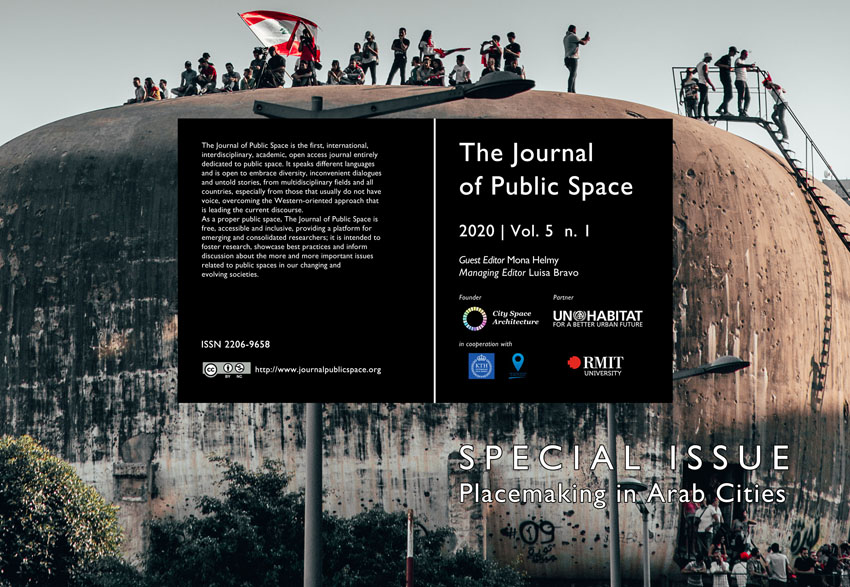Bridges Over the Nile Transportation Corridors Transformed into Public Spaces
##plugins.themes.bootstrap3.article.main##
Abstract
Cairo is a congested city with high rate of urbanization and very limited public space. Cairo has one of the lowest rates of parkland per capita of any major city. Moreover, the banks of the Nile, formerly alive with activities such as washing, fishing, and felucca landings, were by the end of the twentieth century largely cutoff from free public access by a wall of busy roads, private clubs, luxury hotels, restaurants, nurseries, and police/military stations, roads. The need for open space for people from lower income who could not afford the expensive options along the Nile banks, has resulted in use of the sidewalks of the main bridges as public spaces. Families, couples, and friends tolerate the noise and fumes of traffic to enjoy the expansive views and breezes over the Nile. As a result of this extraordinary re-purposing of the bridges, new small businesses have formed to cater to the uses, and a new interaction with the river has emerged. We studied the patterns of use, characteristics of the user population, and stated preferences of users. We identify a set of characteristics contributing to the popularity of the bridges as public space, including affordability, accessibility, openness to the river and visual connection with the other bank. We propose that these characteristics be taken into account when developing future projects along the river water front to address the need for public space and access to the Nile.
##plugins.themes.bootstrap3.article.details##
The Authors retain copyright for articles published in The Journal of Public Space, with first publication rights granted to the journal.
Articles in this journal are published under the Creative Commons Attribution NonCommercial Licence (CC-BY-NC) - https://creativecommons.org/licenses/by-nc/4.0/.
You are free to:
• Share - copy and redistribute the material in any medium or format
• Adapt - remix, transform, and build upon the material
Under the following terms:
• Attribution - You must give appropriate credit, provide a link to the license, and indicate if changes were made. You may do so in any reasonable manner, but not in any way that suggests the licensor endorses you or your use.
• NonCommercial — You may not use the material for commercial purposes.
References
Aga Khan Trust for Culture (2005). Al-Azhar Park, Cairo And the Revitalization of Darb Al-Ahmar. www.akdn.org.
AlSayyad, Nezar (2011). Cairo: Histories of a City. Harvard University Press.
Bartels, Matthias, and Prinz, Dieter (2016). “Urban Agriculture in the Greater Cairo Region”, Deutsche Gesellschaft für Internationale Zusammenarbeit (GIZ) GmbH.
Burke, Stephen (2015). “Building Bridges as Public Spaces, Not Just Infrastructure.” Project for Public Spaces. https://www.pps.org/article/bridges-and-placemaking.
Creswell, John (2003). “Mixed Methods Procedures.” In Research Design: Qualitative, Quantitative, and Mixed Methods Approaches, 208–27.
Economist Intelligence Unit (2011). “Africa Green City Index Report.” https://w5.siemens.com/web/il/en/corporate/home/Siemens_Israel/GreenCityIndex/Documents/Africa Green City Index Report.pdf.
Esri Open Street Map, DeLorme, HERE, USGS, Intermap, iPC, NRCAN, Esri Japan, METI, Esri China (Hong Kong), Esri (Thailand), MapmyIndia, Tomtom (2019). “Open Street Maps.”
Gabr, Hisham S. (2004). “Perception of Urban Waterfront Aesthetics Along the Nile in Cairo, Egypt.” Coastal Management 32 (2): 155–71. https://doi.org/10.1080/08920750490276191.
General Organization for Physical Planning (1982). “The Strategic Urban Development Master Plan Study for Sustainable Development of Greater Cairo Region.” Vol. 2. Cairo.
Iwano, Nao, and Ayaka Amaha Öztürk (2012). “Fishing at the Galata Bridge, Istanbul, in 2011-2012.” J. Black Sea/Mediterranean Environment 18 (2): 223–37.
Jafee, Eric (2015). “Portland’s New Car-Free Bridge Is a Symbol of U.S. Mobility Goals.” City Lab. https://www.citylab.com/transportation/2015/09/portlands-new-car-free-bridge-is-a-symbol-of-us-mobility-goals/404914/.
Kondolf, G. Mathias, and Pedro J. Pinto (2017). “The Social Connectivity of Urban Rivers.” Geomorphology 277: 182–96. https://doi.org/10.1016/j.geomorph.2016.09.028.
Kondolf, G Mathias, Louise Mozingo, Amir Gohar, and Rachael Marzion (2011). “Connecting Cairo to the Nile: Renewing Life and Heritage on the River.” Institute of Urban & Regional Development, 112.
Kondolf, Mathias, and Chia-Ning Yang (2008). “Planning River Restoration Projects: Social and Cultural Dimensions.” In River Restoration, 41–60. John Wiley & Sons, Ltd. https://doi.org/10.1002/9780470867082.ch4.
Libby, Brian (2014). “Why Portland Is Building a Multi-Modal Bridge That Bans Cars.” City Lab. 2014. https://www.citylab.com/transportation/2014/08/why-portland-is-building-a-multi-modal-bridge-that-bans-cars/378665/.
Mantho, Robert, CJ Lim, Aseem Inam, Avi Friedman, and Vikas Mehta (2015). Urban Design: Tools & Resources for the Planning Practitionier. Edited by Rober Mantho, C.J. Lim, Aseem Inam, and Avi Friedman. London: Routledge.
Neuman, William (2010). “Social Research Methods: Qualitative and Quantitative Approaches.” In , 41–67.
Parrish, Jim, Ignacio Bunster-Ossa, Mark Tompkins, and Michael Bastin (2010). “The Trinity River Corridor Project in Dallas, Texas: Enhancing an Urban Ecosystem and Reviving River and Floodplain Open Space to Create Future Sustainable Development Opportunities.” Proceedings of the Water Environment Federation 2010 (2). https://doi.org/10.2175/193864710798285345.
Sims, David (2003). “Urban Slums Reports: The Case of Cairo, Egypt.” In Case Studies for the Global Report on Human Settlements 2003, edited by Development-Planning-Unit-(UCL), 1–24. University College London (UCL). https://doi.org/10.1029/2002GL015399.
The World Bank (2013). “Cairo Traffic Congestion Study Final Report.” Washington DC. https://openknowledge.worldbank.org/handle/10986/18735.

